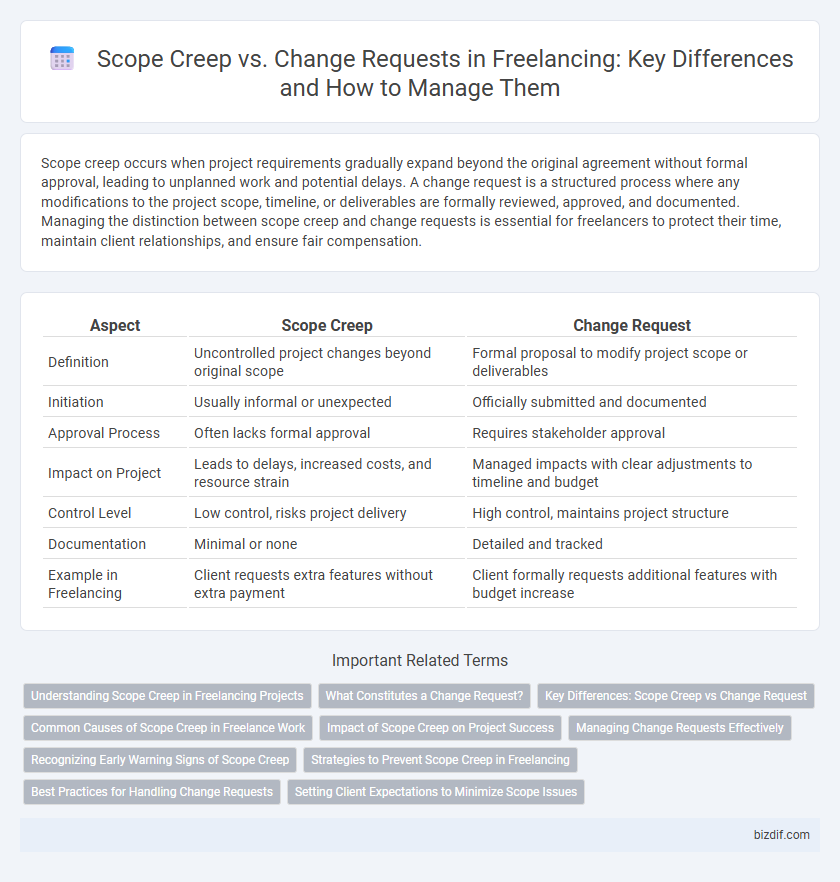Scope creep occurs when project requirements gradually expand beyond the original agreement without formal approval, leading to unplanned work and potential delays. A change request is a structured process where any modifications to the project scope, timeline, or deliverables are formally reviewed, approved, and documented. Managing the distinction between scope creep and change requests is essential for freelancers to protect their time, maintain client relationships, and ensure fair compensation.
Table of Comparison
| Aspect | Scope Creep | Change Request |
|---|---|---|
| Definition | Uncontrolled project changes beyond original scope | Formal proposal to modify project scope or deliverables |
| Initiation | Usually informal or unexpected | Officially submitted and documented |
| Approval Process | Often lacks formal approval | Requires stakeholder approval |
| Impact on Project | Leads to delays, increased costs, and resource strain | Managed impacts with clear adjustments to timeline and budget |
| Control Level | Low control, risks project delivery | High control, maintains project structure |
| Documentation | Minimal or none | Detailed and tracked |
| Example in Freelancing | Client requests extra features without extra payment | Client formally requests additional features with budget increase |
Understanding Scope Creep in Freelancing Projects
Scope creep in freelancing projects occurs when unplanned and unmanaged changes extend the original project scope, leading to increased workload without additional compensation. Unlike formal change requests, which are documented and approved adjustments to project deliverables or timelines, scope creep arises from vague project definitions or client demands outside of the initial agreement. Effective scope management and clear communication are essential to prevent scope creep and maintain project profitability and client satisfaction.
What Constitutes a Change Request?
A change request in freelancing refers to a formal proposal for modifying the original project scope, often involving adjustments to deliverables, deadlines, or budget. It requires client approval and clear documentation to ensure both parties agree on the new terms, preventing misunderstandings and disputes. Properly managing change requests maintains project clarity and helps avoid the negative impact of scope creep on timelines and resources.
Key Differences: Scope Creep vs Change Request
Scope creep occurs when project requirements gradually expand beyond the original agreement without formal approval, leading to unplanned work and potential budget overruns. In contrast, a change request is a formal proposal to alter the project scope, timeline, or deliverables, requiring stakeholder approval before implementation. Understanding these distinctions helps freelancers maintain clear boundaries, manage client expectations, and ensure proper project documentation.
Common Causes of Scope Creep in Freelance Work
Scope creep in freelance work often stems from unclear project goals, lack of detailed contracts, and insufficient communication between clients and freelancers. Changes requested without proper documentation or agreement lead to expanding workloads and missed deadlines. Properly managing change requests with formal approval processes helps prevent uncontrolled scope expansion and preserves project timelines.
Impact of Scope Creep on Project Success
Scope creep significantly jeopardizes project success by introducing unplanned tasks that extend timelines and inflate budgets, leading to resource strain and compromised deliverables. Unlike formal change requests, scope creep lacks structured approval, causing confusion and misaligned expectations between freelancers and clients. Managing scope creep effectively is crucial for maintaining project scope integrity, ensuring timely delivery, and preserving client satisfaction in freelancing projects.
Managing Change Requests Effectively
Managing change requests effectively in freelancing requires clear documentation and communication to prevent scope creep, which can derail project timelines and budgets. Establishing a formal change request process with defined criteria for approval ensures that any adjustments align with the original contract and client expectations. Utilizing project management tools to track and review change requests helps maintain transparency and control over project scope, maximizing client satisfaction and profitability.
Recognizing Early Warning Signs of Scope Creep
Early warning signs of scope creep in freelancing include frequent client requests that extend beyond the original project agreement, unclear or evolving project objectives, and increased time demands without corresponding adjustments in budget or deadlines. Consistent monitoring of project scope and maintaining detailed documentation help identify these indicators early, preventing budget overruns and timeline delays. Clear communication and formalized change requests are essential tools to manage evolving client expectations while protecting project integrity.
Strategies to Prevent Scope Creep in Freelancing
Clear documentation of project deliverables and setting precise expectations with clients are essential strategies to prevent scope creep in freelancing. Implementing a formal change request process allows freelancers to evaluate and approve modifications while maintaining control over time and budget. Regular communication and milestone reviews help identify potential deviations early, minimizing unplanned work and ensuring project alignment.
Best Practices for Handling Change Requests
Effective handling of change requests in freelancing requires clear documentation and mutual agreement to prevent scope creep, which occurs when project requirements expand beyond the initial contract without adjustments. Establishing a formal change request process, including detailed descriptions, impact assessments on timelines and costs, and client approvals, ensures transparency and project control. Maintaining open communication throughout the project helps freelancers manage expectations and deliver on agreed-upon deliverables efficiently.
Setting Client Expectations to Minimize Scope Issues
Setting clear client expectations through detailed project scopes and documented agreements helps minimize scope creep and manage change requests effectively. Defining deliverables, timelines, and costs upfront ensures both parties understand the project's boundaries and the process for handling modifications. Transparent communication and formal change request protocols reduce misunderstandings, protect project budgets, and maintain client satisfaction.
Scope Creep vs Change Request Infographic

 bizdif.com
bizdif.com